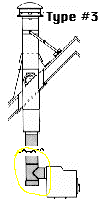This is my first post so be easy on me please....lol. I've searched the forum and have seen a lot of tips and good advice but nothing specific to my setup. So here is what I am facing and would appreciate any and all advice:
Stove: Going to pick up a gently used Woodstock Fireview this weekend. Has all new gaskets and newer SS catalyst.
House: Recently purchased 2 1/2 story 1887 Victorian. Has two coal burning fireplaces but the chimneys have been knocked down below roof level inside the 1/2 story attic. They are still intact and in great condition from there to the fireplaces. They are not lined.
Climate: Southcentral Kansas
Plans: Place Fireview in front of coal fireplace and run stove pipe up through existing brick chimney and out the roof. This particular room would exit straight through the ridge if that is what I wanted. I do know i could box it in and go that route but they want entirely too much for the ridge flashing to accommodate that. Easier and cheaper to do a couple of 15 deg bends and go out through the roof.
I would like to use single wall stove pipe from the Fireview up through the chimney until the chimney stops in the 1/2 story attic. From there I am thinking of going to double wall through the rest of the open 1/2 attic and through the roof and 2 ft above the highest point.
Keep in mind that each of the first two floors have 10 ft ceilings and the 1/2 story is about 8 ft to where I am going to exit the roof so I am trying to keep costs down while still being safe.
Let me know if I am on the right track or not, what you have done or would do, pipe dia for that long of a run, etc....
I used an existing wood stove in my country house the past 22 years so I know what and how to burn just not sure on exactly how to set this one up.
Thanks in advance,
Dennis
Stove: Going to pick up a gently used Woodstock Fireview this weekend. Has all new gaskets and newer SS catalyst.
House: Recently purchased 2 1/2 story 1887 Victorian. Has two coal burning fireplaces but the chimneys have been knocked down below roof level inside the 1/2 story attic. They are still intact and in great condition from there to the fireplaces. They are not lined.
Climate: Southcentral Kansas
Plans: Place Fireview in front of coal fireplace and run stove pipe up through existing brick chimney and out the roof. This particular room would exit straight through the ridge if that is what I wanted. I do know i could box it in and go that route but they want entirely too much for the ridge flashing to accommodate that. Easier and cheaper to do a couple of 15 deg bends and go out through the roof.
I would like to use single wall stove pipe from the Fireview up through the chimney until the chimney stops in the 1/2 story attic. From there I am thinking of going to double wall through the rest of the open 1/2 attic and through the roof and 2 ft above the highest point.
Keep in mind that each of the first two floors have 10 ft ceilings and the 1/2 story is about 8 ft to where I am going to exit the roof so I am trying to keep costs down while still being safe.
Let me know if I am on the right track or not, what you have done or would do, pipe dia for that long of a run, etc....
I used an existing wood stove in my country house the past 22 years so I know what and how to burn just not sure on exactly how to set this one up.
Thanks in advance,
Dennis


 !
!